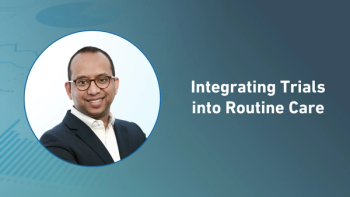Key Takeaways
Community trials drive access and diversity: Embedding clinical trials in local oncology practices improves patient access, enhances diversity, and helps overcome geographic and financial barriers that traditionally limit participation.
Patient-centered infrastructure improves engagement: Familiar care teams, streamlined intake, nurse navigators, and culturally competent communication foster trust and continuity—leading to higher enrollment and retention rates.
Operational efficiency without compromising rigor: Community sites can accelerate trial startup and dosing timelines while maintaining high research standards, proving that decentralized models can deliver both scientific and operational success.
Participation in cancer treatment clinical trials remains low, with only 7.1% of adult cancer patients in the US enrolling in such trials, and trial participation still heavily concentrated in academic medical centers and urban settings, according to a 2023 study in the Journal of Clinical Oncology.1 Furthermore, of those who participated in treatment trials, enrollment at community sites was just 4.1% compared to a five-fold higher rate (21.6%) at National Cancer Institute-designated cancer centers.
This is despite the fact that approximately 80% of cancer patients would prefer to receive care in community oncology settings. But access to trials is limited at many community sites, so patients continue to face logistical and structural barriers to participation.
By embedding trials within local oncology practices and care centers, community-based clinical trial sites can improve access and reduce challenges for patients while maintaining rigorous research standards. Clinical trial infrastructure can operate effectively outside large academic hubs, bringing early-phase cancer research closer to where patients live and receive care.
This article explores how patient engagement can be strengthened in community-based research settings, drawing on lessons from The START Center for Cancer Research's experience to identify strategies that can close the participation gap.
How community-based trials strengthen patient engagement
Patients are more likely to participate in and complete a clinical trial when they feel comfortable, informed, and supported. Community-based research settings provide a familiar, less intimidating environment that encourages open communication and sustained participation.
In many cases, the trust patients have in their local physicians and care teams plays a critical role. Rather than navigating complex systems with a myriad of providers or starting a trial at a large academic hospital which can be intimidating, patients in community trials often remain under the care of providers they already know.
Conducting research in community settings also increases the likelihood of enrolling a diverse and representative patient population. Trials based in local clinics can reach groups that are often excluded due to distance or financial hardship. By situating trials closer to patients’ homes and offering culturally competent care, these models reduce barriers and build trust.
Clinical trial sites located in the community reduce the need for long-distance travel and enhance access for patients who might otherwise be left out of treatment options. Reframing access as not only a question of geography, but also of trust, language, and cultural relevance, is essential to improving patient engagement and equity in oncology research.
Fostering patient-centered engagement in community trials
Building meaningful engagement in community trials requires infrastructure and processes that put patients first. Several core enablers contribute to this:
- Continuity in care and collaboration between physicians: One of the key advantages of community-based trials is that patients typically see the same core care team, including their treating physician, nurse, and research coordinator, throughout the study. This consistent team dynamic builds trust and ensures care is informed by a deep understanding of the patient’s history. Investigators in these settings are often more hands-on, frequently reviewing data and checking in with patients directly. Additionally, because the referring physician or community oncologist and the clinical trial investigators are located in the same or a nearby community, they are able to collaborate more fluidly. It is common for a patient’s referring oncologist and their trial investigator to know each other professionally and coordinate care directly. These informal relationships allow for more timely discussions about patient needs, eligibility, and treatment progress.
- Reducing geographic and financial barriers: Community trials reduce burdens that commonly limit participation, namely travel, time away from work, and added expenses. For many patients, receiving treatment at a familiar local site means they can return home the same day, even after intensive therapies such as chemotherapy. This stands in contrast to large academic centers, where patients may need to stay overnight in unfamiliar cities or make repeated long-distance trips. Getting their care close to home makes participation more feasible, especially for patients balancing caregiving, employment, or limited mobility.
- Local care teams and navigators: Nurse navigators and intake specialists help guide patients through the screening, consent, and onboarding process. Nurse navigators play a dual role: they support patients clinically and emotionally, and also help to maintain engagement by coordinating across departments and monitoring patient eligibility, ensuring no one falls through the cracks.
- Streamlined intake and trial matching: Community sites often simplify trial entry through coordinated referral systems and rapid collection of medical records. Intake specialists and nurse navigators form a coordinated triage team. Intake specialists collect referrals from a wide range of sources—including self-referrals, community physicians, and partner practices—and are responsible for obtaining relevant medical records from each source. Although the process can be labor-intensive, it adds substantial value to the patient experience. Without this support, patients are often left to navigate the system alone—calling multiple clinics, requesting documents, and piecing together records from various portals. By centralizing and expediting this process, intake teams alleviate patient burden and ensure that clinical teams have the information they need for timely and informed trial matching. Nurse navigators then work closely with the nursing team to conduct a clinical review, assess eligibility, and present the patient’s case during a weekly consult meeting. This ensures that, by the time the patient arrives, the trial matching process is already well underway, saving time and reducing unnecessary visits.
- Tailored communication strategies: Effective patient education must consider health literacy, language, and cultural nuances. Community sites can increase patient engagement by providing consent materials in multiple languages and proactively identifying each patient's preferred learning style. Teams may offer printed handouts, verbal summaries, or extended in-person explanations, depending on each patient’s preferences. In areas with large Spanish-speaking populations for example, bilingual staff may assist patients in reviewing study requirements and answer questions in their native language.
- Technology enablement: While many community sites operate with limited resources, some are investing in tailored technology solutions to support patient engagement and operational efficiency. For instance, START's internal custom trial matching tool is being developed to draw upon structured clinical data, such as prior lines of therapy, biomarker profiles, next-generation sequencing results, and clinical timelines. The tool integrates this data with eligibility criteria to allow teams to proactively surface trial options and match patients to appropriate studies—helping physicians provide trial options more quickly and efficiently.
These enablers help reduce drop-off, enhance trust, and ensure that patients enroll and stay engaged throughout the study.
Measurable benefits from the community-based model
Studies have shown that embedding clinical trials in community settings can significantly boost enrollment and retention rates. One study conducted in rural Nebraska found that trial enrollment increased seven-fold at a community oncology site when it was provided with adequate clinical trial infrastructure as part of a National Cancer Institute Community Cancer Centers Program.2
Operationally, evidence from START's experience in running clinical trials at community sites shows that they are often among the first to dose a patient due to faster feasibility assessments and streamlined startup processes. These sites frequently maintain close communication with all stakeholders—referring physicians, oncologists and the trial sponsors—and are well-prepared to act on sponsor timelines.
Community-based models have also improved patient satisfaction in ways that reflect the deeper personal connections formed in smaller, localized settings. Patients consistently report higher levels of comfort and clarity when supported by care teams they see regularly and know by name. The familiarity of returning to the same environment—with the same coordinator checking them in, the same nurse administering treatment, and the same physician explaining updates—helps ease anxiety and build confidence.
Anecdotally, some patients describe knowing exactly which chair they’ll sit in for infusion or appreciating that the front desk staff remembers their name and routine. Others have noted the relief of being able to go home immediately after chemotherapy, rather than needing to stay overnight in a hotel or navigate unfamiliar hospital systems. This sense of continuity and predictability in community sites are tangible benefits that help patients stay engaged in the trial while balancing work and life commitments.
Importantly, these models enhance trial diversity by removing financial and logistical barriers. By enabling participation closer to home and offering culturally tailored engagement, community trials better reflect real-world populations, thereby improving the generalizability and equity of trial outcomes.
Conclusion: Scaling access and engagement
If the future of oncology research is to be inclusive, efficient, and representative, community-based clinical trials must be part of the solution. As demonstrated, decentralized models can dramatically improve patient engagement and experience, while maintaining academic rigor and providing more efficient trial operation.
Scaling these models will require investment in staff training, trial infrastructure, and localized engagement strategies. Sponsors and research networks must continue to prioritize community site selection, recognize operational differences, and design protocols with real-world settings in mind.
Technology will also play a key role in advancing engagement. From smarter trial-matching tools to more personalized communication, innovation must focus on improving access without losing the human connection that defines the community setting.
Ultimately, expanding access to clinical trials is both a practical and strategic priority. Designing research that is embedded in the communities where patients live helps ensure broader participation and more inclusive outcomes.
Katie Celentino, DNP, RN, CMSRN, is the vice president of regional operations at The START Center for Cancer Research
References
- Unger JM, Shulman LN, Facktor MA, Nelson H, Fleury ME. National Estimates of the Participation of Patients With Cancer in Clinical Research Studies Based on Commission on Cancer Accreditation Data. J Clin Oncol. 2024;42(18):2139-2148. doi:10.1200/JCO.23.01030
- Copur MS, Ramaekers R, Gönen M, et al. Impact of the National Cancer Institute Community Cancer Centers Program on Clinical Trial and Related Activities at a Community Cancer Center in Rural Nebraska [published correction appears in J Oncol Pract. 2016 Sep;12(9):830. doi: 10.1200/JOP.2016.016899.]. J Oncol Pract. 2016;12(1):67-e51. doi:10.1200/JOP.2015.005736







.png)



.png)



.png)
.png)
